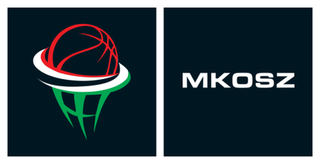
EuroBasket, also commonly referred to as the European Basketball Championship, is the main international basketball competition that is contested quadrennially, by the senior men's national teams that are governed by FIBA Europe, which is the European zone within the International Basketball Federation.

The Italy men's national basketball team represents Italy in international basketball tournaments. They are administered by the Italian Basketball Federation (FIP).

The Czechoslovakia national basketball team represented Czechoslovakia in international basketball from 1932 to 1992. After the Dissolution of Czechoslovakia in 1993, the Czech Republic and Slovakia set up their own national teams. The present-day Czech Republic national basketball team is recognized as the successor to the Czechoslovak team.

The Belgium men's national basketball team has represented Belgium in international basketball since 1928. The supervising body for the national team is Basketball Belgium.

The Hungary men's national basketball team represents Hungary in international basketball tournaments. It is governed by the Hungarian Basketball Federation (MKOSZ).

The 1937 FIBA European Championship, commonly called FIBA EuroBasket 1937, was the second FIBA EuroBasket regional basketball championship, held by FIBA. Eight national teams affiliated with the International Basketball Federation (FIBA) took part in the competition. Defending champions Latvia hosted the tournament, held in Riga.
The 1947 FIBA European Championship, commonly called FIBA EuroBasket 1947, was the fifth FIBA EuroBasket regional basketball championship, held by FIBA. Fourteen national teams affiliated with the International Basketball Federation (FIBA) took part in the competition. Czechoslovakia hosted the contest, which was held in Prague.
The 1949 FIBA European Championship, commonly called FIBA EuroBasket 1949, was the sixth FIBA EuroBasket regional basketball championship, held by FIBA. Seven national teams affiliated with the International Basketball Federation (FIBA) took part in the competition. The competition was hosted by Egypt after the Soviet Union refused to host it, as was the Soviet's obligation as defending champion under FIBA Europe rules. Czechoslovakia, the silver medallist at EuroBasket 1947, had been the host that year, so was not asked to repeat hosting duties and those duties fell to bronze medallist Egypt.
The 1951 FIBA European Championship, commonly called FIBA EuroBasket 1951, was the seventh FIBA EuroBasket regional basketball championship, held by FIBA. Eighteen national teams affiliated with the International Basketball Federation (FIBA) entered the competition, a record number and more than twice the number that had competed two years earlier. The competition was hosted by France, who had taken second place at EuroBasket 1949, behind 1949 hosts Egypt. The Vélodrome d'hiver, Paris was the location of the event.
The 1953 FIBA European Championship, commonly called FIBA EuroBasket 1953, was the eighth FIBA EuroBasket regional basketball championship, held by FIBA. Seventeen national teams affiliated with the International Basketball Federation (FIBA) entered the competition. The competition was hosted by the Soviet Union, champions of EuroBasket 1951. Moscow was the location of the event.

The 1955 FIBA European Championship, commonly called FIBA EuroBasket 1955, was the ninth FIBA EuroBasket regional basketball championship, held by FIBA. Eighteen national teams affiliated with the International Basketball Federation (FIBA) entered the competition. The competition was hosted by Hungary, silver medal winners of EuroBasket 1953. Budapest was the location of the event.
The 1957 FIBA European Championship, commonly called FIBA EuroBasket 1957, was the tenth FIBA EuroBasket regional basketball championship, held by FIBA Europe. Sixteen national teams affiliated with the International Basketball Federation (FIBA) entered the competition. The competition was hosted by Bulgaria. Vasil Levski National Stadium in Sofia was the location of the event.

The 1959 FIBA European Championship, commonly called FIBA EuroBasket 1959, was the eleventh FIBA EuroBasket regional basketball championship, held by FIBA Europe. The tournament, which was hosted by Turkey, began on 21 May 1959 and concluded with the final on 31 May 1959. Seventeen national teams affiliated with the International Basketball Federation (FIBA) entered the competition. Mithat Paşa Stadium, Istanbul was the location of the event.

The 1979 FIBA European Championship, commonly called FIBA EuroBasket 1979, was the 21st FIBA EuroBasket regional basketball championship, held by FIBA Europe. Twelve national teams affiliated with the International Basketball Federation entered the competition. The competition was hosted by Italy. Mestre, Siena, Gorizia and Turin were the venues of the event.

The 1983 FIBA European Championship, commonly called FIBA EuroBasket 1983, was the 23rd FIBA EuroBasket regional basketball championship, held by FIBA Europe. It took place from 26 May to 4 June 1983 in France. Italy defeated Spain in the final to win their first title.
The 1993 FIBA European Championship, commonly called FIBA EuroBasket 1993, was the 28th FIBA EuroBasket regional basketball championship, held by FIBA Europe. It was held in Germany between 22 June and 4 July 1993. Sixteen national teams entered the event under the auspices of FIBA Europe, the sport's regional governing body. The cities of Berlin, Karlsruhe and Munich hosted the tournament. Hosts Germany won their first FIBA European title by defeating Russia with a 71–70 score in the final. Germany's Chris Welp was voted the tournament's MVP. This edition of the FIBA EuroBasket tournament also served as qualification for the 1994 FIBA World Championship, giving a berth to the top five teams in the final standings.
Ladislav Trpkoš was a Czech basketball player. He was voted to the Czechoslovakian 20th Century Team in 2001.

The 2009 European Women Basketball Championship, commonly called EuroBasket Women 2009, was the 32nd regional championship held by FIBA Europe. The competition was held in Latvia from June 7 to June 20, 2009.

EuroBasket 2015 was the 39th edition of the EuroBasket championship that was organized by FIBA Europe. It was co-hosted by Croatia, France, Germany, and Latvia, making it the first EuroBasket held in more than one country. It started on 5 September and ended on 20 September 2015.
Miroslav Škeřík was a Czech professional basketball player. At 6'5 3⁄4" tall, he played the center position. He was the top scorer of EuroBasket 1955, averaging 19.1 points per game.










